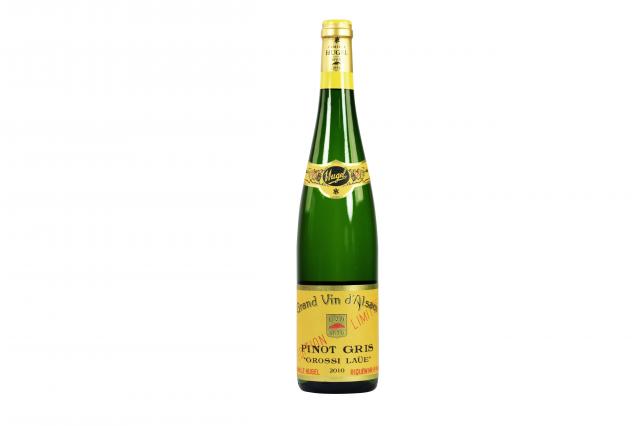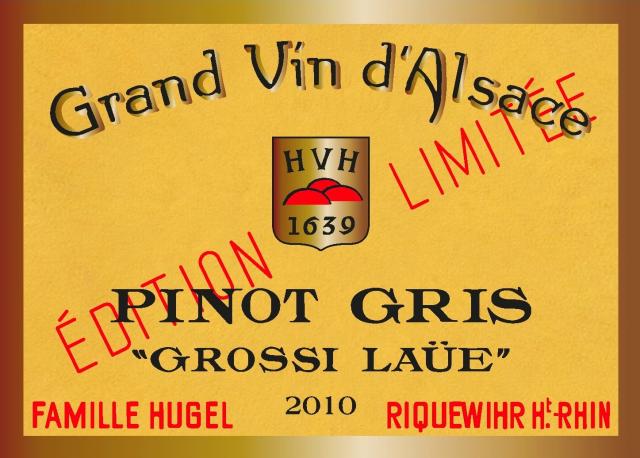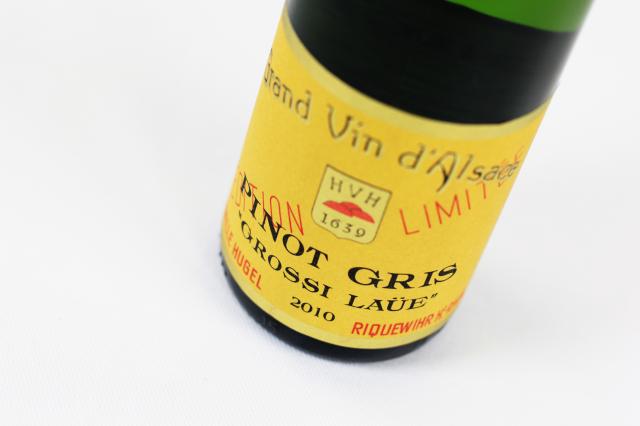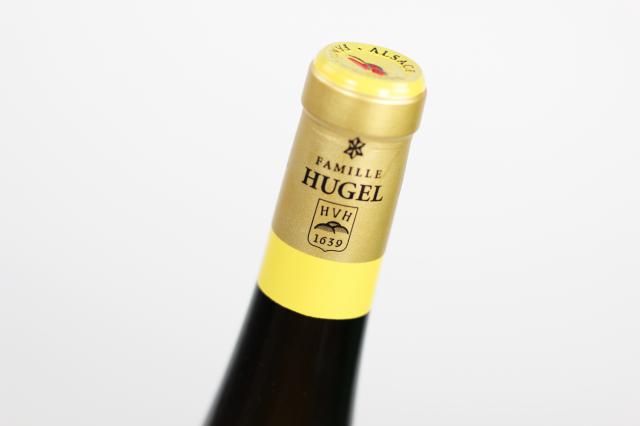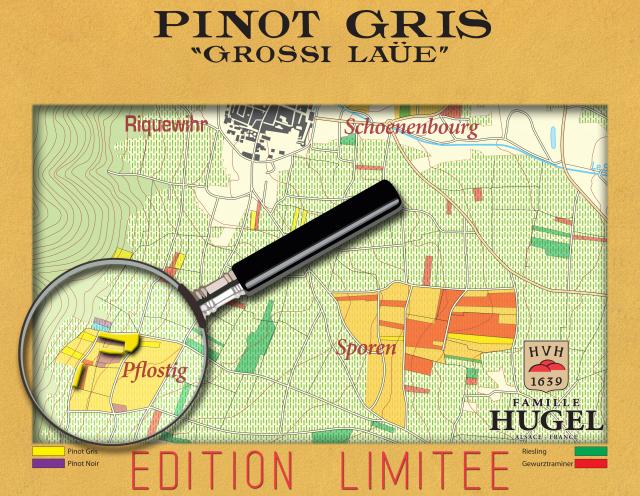Famille Hugel
Pinot Gris GROSSI LAUE 2015
Grossi Laüe signifies the finest vineyards in Alsace dialect and represents an equivalent to the German Grosses Gewächs or the Burgundian Grand Cru.
Specifications
Alcohol content : 14.7 % vol.
Residual Sugar : 9.8 g/l
Tartaric acidity : 6.57 g/l
pH : 3.22
Age of vines : 33 years old
Yield : 46 hL/ha
Presentation
Quick View
Great classic Pinot Gris which will gain in complexity for 8 years or more. Its minerality and long complex aftertaste will make it the ideal partner to white meat and dishes with mushrooms.
The vintage
2015 will go down as an exceptional vintage year for the whole of France. After one of the hottest and driest summers since 2003 and a harvest quality to rivals those of the great "solar" vintages of 1945, 1976, 1989 and 2009, the Alsace region will be no exception.
The year started with quite normal weather conditions, a total of 6 days below freezing (up to -6°C) during the winter. The spring was, however, pleasant and sunny. The vines budded slightly later than usual, around the 13 April, and blossomed during the first weeks of June, indicating an early vintage. This was normal considering the low rain fall, a record of only 30mm between 4 May and 24 July! These dry conditions were compounded by a heatwave that lasted for almost the whole of July.
By the time the grapes started to ripen, the vines were suffering, especially in the more well-drained soils with limited reserves of water. Riquewihr and its loamy soil seemed to have escaped the worst of this and the heavy rain that came in mid-August saved the harvest just in time.
We started grape-picking on the 10 September, three days later than the rest of the Alsace, and the first grapes to arrive in the winery gave every indication of an exceptional vintage year. The grapes were perfectly healthy and ripe; their supple acidity was a taste of great wine to come. The Pinots, especially the magnificent Pinot Noir, of this great "solar" year were highly appreciated.
Only one day of rain disrupted the harvest, which was already well underway at the time.
The rapid acceleration of the ripening during the third week and a nice outbreak of botrytis meant the most part of our Riesling de Schoenenbourg were harvested late, and once again the Engelkritt (Angels' Vine) won us not one but two of the "Sélection de Grains Nobles" awards for this grape variety, the most concentrated being at a potential of 23°!
The year started with quite normal weather conditions, a total of 6 days below freezing (up to -6°C) during the winter. The spring was, however, pleasant and sunny. The vines budded slightly later than usual, around the 13 April, and blossomed during the first weeks of June, indicating an early vintage. This was normal considering the low rain fall, a record of only 30mm between 4 May and 24 July! These dry conditions were compounded by a heatwave that lasted for almost the whole of July.
By the time the grapes started to ripen, the vines were suffering, especially in the more well-drained soils with limited reserves of water. Riquewihr and its loamy soil seemed to have escaped the worst of this and the heavy rain that came in mid-August saved the harvest just in time.
We started grape-picking on the 10 September, three days later than the rest of the Alsace, and the first grapes to arrive in the winery gave every indication of an exceptional vintage year. The grapes were perfectly healthy and ripe; their supple acidity was a taste of great wine to come. The Pinots, especially the magnificent Pinot Noir, of this great "solar" year were highly appreciated.
Only one day of rain disrupted the harvest, which was already well underway at the time.
The rapid acceleration of the ripening during the third week and a nice outbreak of botrytis meant the most part of our Riesling de Schoenenbourg were harvested late, and once again the Engelkritt (Angels' Vine) won us not one but two of the "Sélection de Grains Nobles" awards for this grape variety, the most concentrated being at a potential of 23°!
In the vineyard
From a selection of the 3 finest plots of the Hugel estate in the chalky Pflostig
Winemaking
The grapes are taken in small tubs to the presses, which are filled by gravity, without any pumping or other mechanical intervention.
After pressing, the must is decanted for a few hours, then fermented in temperature-controlled barrels or vats (at 18 to 24°C). The following spring, the wine was lightly filtered just before bottling, and the bottles were then aged extensively in our cellars until released for sale.
The whole production of this wine is closed with DIAM the cork without the risk of cork taint.
After pressing, the must is decanted for a few hours, then fermented in temperature-controlled barrels or vats (at 18 to 24°C). The following spring, the wine was lightly filtered just before bottling, and the bottles were then aged extensively in our cellars until released for sale.
The whole production of this wine is closed with DIAM the cork without the risk of cork taint.
Presentation
Brochure introducing the Grossi Laüe range
Video: Geology and terroirs of Riquewihr
Video: Geology and terroirs of Riquewihr
Varietal
Pinot gris : 100%
Specifications
Alcohol content : : 14.7 % vol.
Residual Sugar : : 9.8 g/l
Tartaric acidity : : 6.57 g/l
pH : : 3.22
Age of vines : : 33 years old
Yield : : 46 hL/ha
Advice
Video
Tasting notes by Serge Dubs, World's Best Sommelier 1989
This wine's colour is both dense and profound with straw yellow highlights and hints of pistachio green; the legs are smooth, sophisticated, supple and tight with their own very pleasing shimmer.
The nose is harmonious, smooth, openly expressive and pleasantly aromatic with deep hints of fruit: pear, baked apple, Mirabelle, apricot, acacia blossom, wild-flower honey, liquorice and hints of peppermint, vanilla and nutmeg. All of this is both appealing and flattering.
On the palate this is a fine example of durability, harmony and flavour.
It is both generous and juicy without being too heavy thanks to the elegant freshness of its full rounded and nicely aromatic final note.
This is a wine that is very easy to approach thanks to its well-stated and clear nature and its wonderful equilibrium and harmony.
Can be consumed immediately or laid down for 5 to 10 years.
Best served during a meal at 8°C, ideal with fish, white meat or pan-fried or oven-baked foie gras.
With any flavoursome or rich dish. With meat: veal, pork, pheasant, partridge, game pie with foie gras.
With black truffle, especially if it has been laid down for 5 to 12 years.
Fish dishes with strong flavours and spices such as turmeric, saffron, pink peppercorn, red mullet, lobster, king prawns, freshwater shrimp.
The nose is harmonious, smooth, openly expressive and pleasantly aromatic with deep hints of fruit: pear, baked apple, Mirabelle, apricot, acacia blossom, wild-flower honey, liquorice and hints of peppermint, vanilla and nutmeg. All of this is both appealing and flattering.
On the palate this is a fine example of durability, harmony and flavour.
It is both generous and juicy without being too heavy thanks to the elegant freshness of its full rounded and nicely aromatic final note.
This is a wine that is very easy to approach thanks to its well-stated and clear nature and its wonderful equilibrium and harmony.
Can be consumed immediately or laid down for 5 to 10 years.
Best served during a meal at 8°C, ideal with fish, white meat or pan-fried or oven-baked foie gras.
With any flavoursome or rich dish. With meat: veal, pork, pheasant, partridge, game pie with foie gras.
With black truffle, especially if it has been laid down for 5 to 12 years.
Fish dishes with strong flavours and spices such as turmeric, saffron, pink peppercorn, red mullet, lobster, king prawns, freshwater shrimp.
